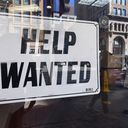America's new labor market

More warehouse workers, fewer waiters. More health store employees, fewer in public schools: the overall job market is nearly back to full strength, but it looks strikingly different.
Why it matters: Pandemic-era disruptions have shaken up the composition of the labor force — with big implications for how industries will have to adjust to a longer-term worker shortfall.
- What they're saying: "I'm not looking for recovery to pre-pandemic levels in each industry. Some workers have left for greener pastures and that's a good thing," Ellen Gaske, an economist at PGIM Fixed Income, tells Axios.
- "There is more opportunity for workers to return to new jobs — where the industries are growing and the outlook is potentially brighter. That churning is what offers up a possibility of stronger productivity gains and increased standard of living."
What's new: With May's payroll gains, roughly 96% of jobs lost during the pandemic are back.
- Stunning stat: The private sector has recovered 99% of all jobs lost, but public sector has regained just 58% — one illustration of the gaping hole that persists in certain areas of the economy.
- Other industries have recovered and then some: the transportation and warehousing sector — think package couriers or truckers — has never made up a bigger share of the workforce, reflecting, for one, the historic appetite for goods.
What's going on: A collision of forces — some structural, some cyclical and some already underway before the pandemic hit — are pushing workers away from some jobs and toward others, according to a recent report by Burning Glass Institute, a research firm. Among the changes ...
- The remote work allure: “The pandemic created this huge wedge. People want to move out of in-person roles — leisure and hospitality or education — and move toward the kinds of occupations and industries with more flexibility," Julia Pollak, chief economist at ZipRecruiter, tells Axios.
- The goods spending boom: At the onset of the pandemic, stuck-at-home consumers bought more goods than services. But economists expect employment in consumer goods to cool off as spending on services continues to boomerang back.
- Where the wages are: "Private sector employers have an advantage in this environment. They can adjust their compensation plan and policies very quickly," says Pollak. The public sector has been slower to respond, one factor perhaps pushing these workers to other gigs.
The bottom line: America's labor market recovery has been swift. The next test is which industries fully recover — and which don't.